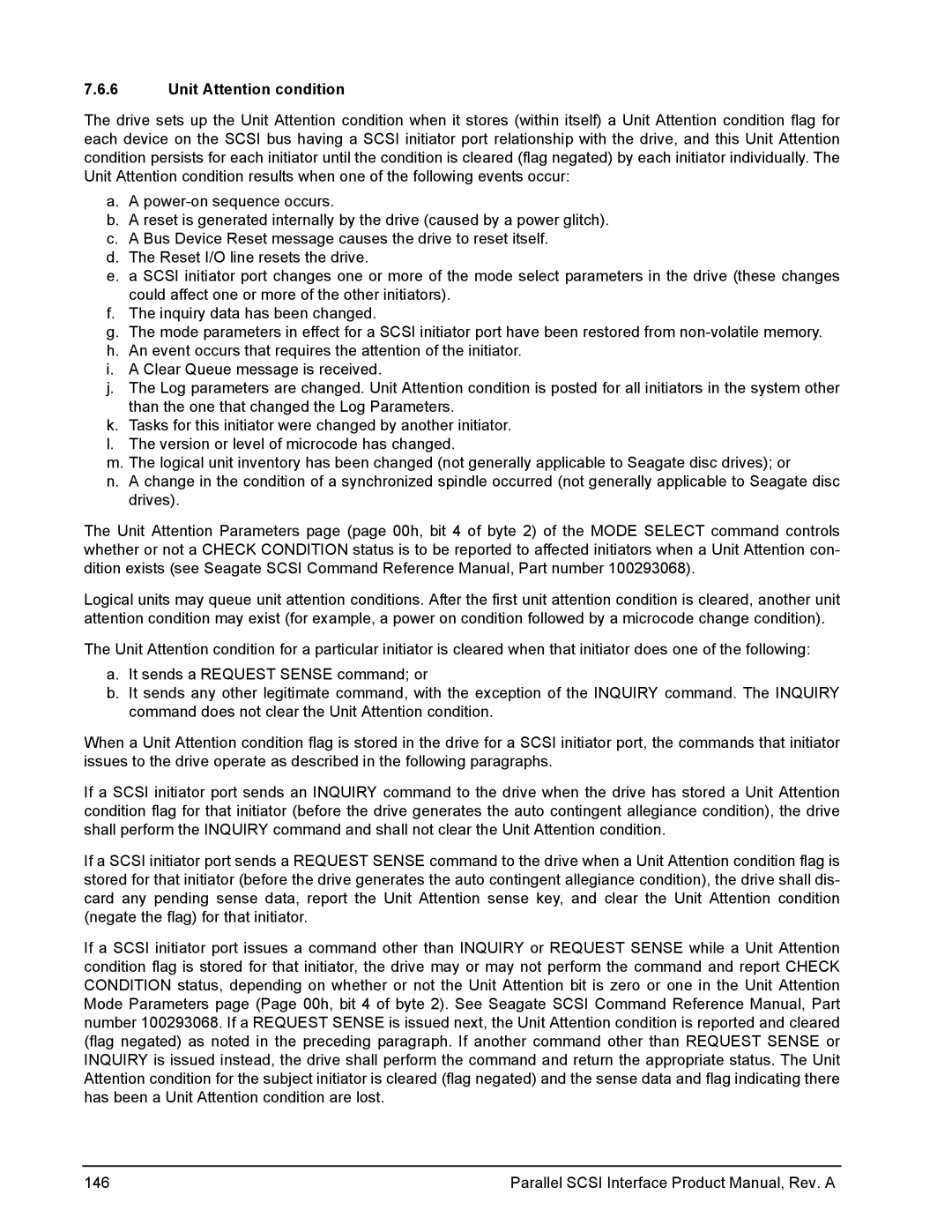7.6.6Unit Attention condition
The drive sets up the Unit Attention condition when it stores (within itself) a Unit Attention condition flag for each device on the SCSI bus having a SCSI initiator port relationship with the drive, and this Unit Attention condition persists for each initiator until the condition is cleared (flag negated) by each initiator individually. The Unit Attention condition results when one of the following events occur:
a.A
b.A reset is generated internally by the drive (caused by a power glitch).
c.A Bus Device Reset message causes the drive to reset itself.
d.The Reset I/O line resets the drive.
e.a SCSI initiator port changes one or more of the mode select parameters in the drive (these changes could affect one or more of the other initiators).
f.The inquiry data has been changed.
g.The mode parameters in effect for a SCSI initiator port have been restored from
h.An event occurs that requires the attention of the initiator.
i.A Clear Queue message is received.
j.The Log parameters are changed. Unit Attention condition is posted for all initiators in the system other than the one that changed the Log Parameters.
k.Tasks for this initiator were changed by another initiator.
l.The version or level of microcode has changed.
m.The logical unit inventory has been changed (not generally applicable to Seagate disc drives); or
n.A change in the condition of a synchronized spindle occurred (not generally applicable to Seagate disc drives).
The Unit Attention Parameters page (page 00h, bit 4 of byte 2) of the MODE SELECT command controls whether or not a CHECK CONDITION status is to be reported to affected initiators when a Unit Attention con- dition exists (see Seagate SCSI Command Reference Manual, Part number 100293068).
Logical units may queue unit attention conditions. After the first unit attention condition is cleared, another unit attention condition may exist (for example, a power on condition followed by a microcode change condition).
The Unit Attention condition for a particular initiator is cleared when that initiator does one of the following:
a.It sends a REQUEST SENSE command; or
b.It sends any other legitimate command, with the exception of the INQUIRY command. The INQUIRY command does not clear the Unit Attention condition.
When a Unit Attention condition flag is stored in the drive for a SCSI initiator port, the commands that initiator issues to the drive operate as described in the following paragraphs.
If a SCSI initiator port sends an INQUIRY command to the drive when the drive has stored a Unit Attention condition flag for that initiator (before the drive generates the auto contingent allegiance condition), the drive shall perform the INQUIRY command and shall not clear the Unit Attention condition.
If a SCSI initiator port sends a REQUEST SENSE command to the drive when a Unit Attention condition flag is stored for that initiator (before the drive generates the auto contingent allegiance condition), the drive shall dis- card any pending sense data, report the Unit Attention sense key, and clear the Unit Attention condition (negate the flag) for that initiator.
If a SCSI initiator port issues a command other than INQUIRY or REQUEST SENSE while a Unit Attention condition flag is stored for that initiator, the drive may or may not perform the command and report CHECK CONDITION status, depending on whether or not the Unit Attention bit is zero or one in the Unit Attention Mode Parameters page (Page 00h, bit 4 of byte 2). See Seagate SCSI Command Reference Manual, Part number 100293068. If a REQUEST SENSE is issued next, the Unit Attention condition is reported and cleared (flag negated) as noted in the preceding paragraph. If another command other than REQUEST SENSE or INQUIRY is issued instead, the drive shall perform the command and return the appropriate status. The Unit Attention condition for the subject initiator is cleared (flag negated) and the sense data and flag indicating there has been a Unit Attention condition are lost.
146 | Parallel SCSI Interface Product Manual, Rev. A |
